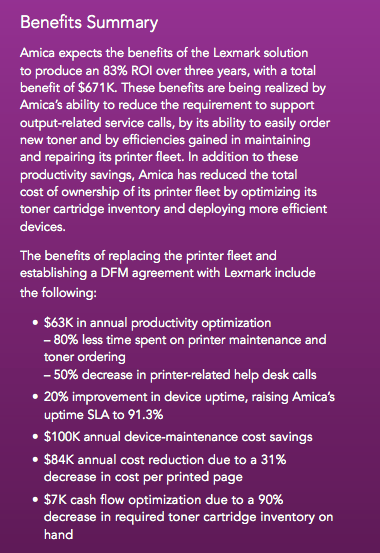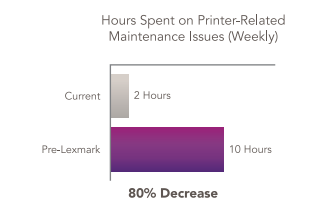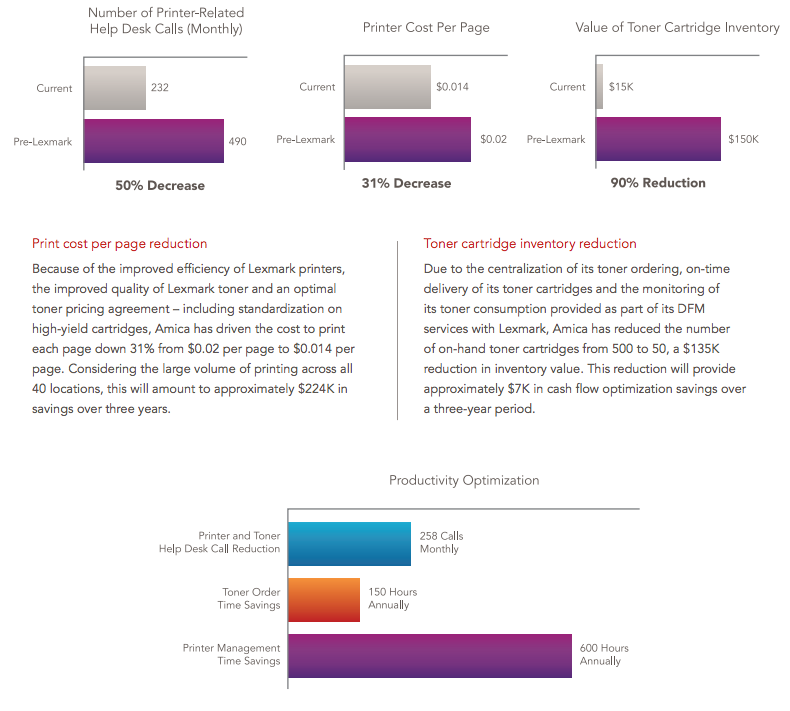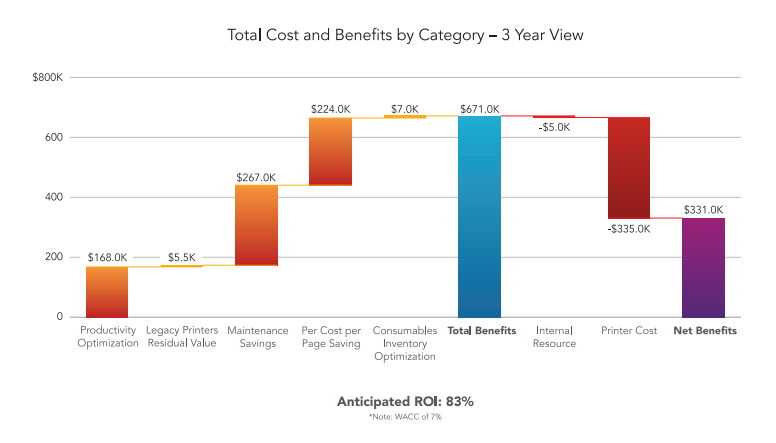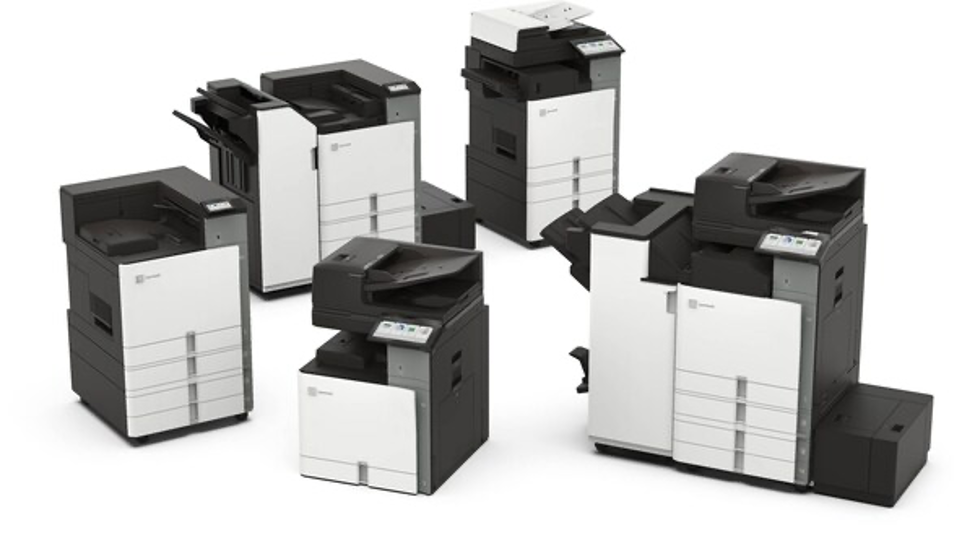Executive Summary
Not long ago, Amica found itself maintaining a problematic fleet of printers. Significant time was being spent maintaining printers, handling help desk calls to correct printer problems, ordering toner and managing the complexities of an aging, diverse printer fleet with units spread across 39 separate branch locations and at headquarters.
Amica turned to its long-time partner, Lexmark, to help the company reduce output costs, improve the performance of its devices and reduce the administrative and IT burden of maintaining the devices. In just under two months, Lexmark replaced all of the legacy printers at Amica and established a distributed fleet management (DFM) partnership with Lexmark that has significantly reduced its printer maintenance and management costs.
As part of the agreement, Lexmark replaced all of Amica’s printers with new, faster and more feature-rich devices, began monitoring the devices proactively over the network to diagnose issues before they impacted end users and established a plan so that it would automatically detect toner-low conditions so that replacement cartridges could be shipped just in time to the right location, rather than stockpiling back-ups.
The Challenge
Amica found itself with a fleet of printers that were becoming increasingly expensive to maintain. These costs, compounded with frequent outages across the company’s branch and headquarters locations, were putting a significant burden on its IT and administrative resources.
Highlights
Amica’s benefits will produce an 83% ROI over three
years on $671K of total savings. Major drivers of these
benefits include:
- $224K in print cost per page savings
- $267K device maintenance cost savings
- $168K in productivity optimization
- $7K in inventory carry cost reductions
- $5K in legacy printer residual value
- 20% device uptime improvement
- Saved time for IT administration allowing resources to focus on more strategic, value-added initiatives
Calls to its help desk to resolve recurring printer issues were frequent. The devices were often out of commission for extended periods because printer technicians would arrive without the correct parts to fix the problems, thereby hampering branch office operations.
Servicing the aging printer fleet had become very costly for Amica. The company estimated that it was spending more than $100K per year just to maintain the fleet. Adding to these costs, Amica was storing large quantities of toner cartridges in inventory because there was no cost effective, efficient way to order the cartridges ahead of time.
Administrative assistants would order extra cartridges just in case they were needed, and many remained in closets, unused and tying up precious capital. Given the resource and cost inefficiencies of its legacy printer fleet, Amica’s IT leadership realized it was time to investigate new fleet replacement alternatives and a new approach to keeping a new fleet up and running efficiently.
Amica turned to Lexmark for answers. In short order, Lexmark was able to demonstrate how its DFM offerings could vastly improve the efficiency and management of Amica’s printer fleet. Lexmark’s DFM services provided Amica with a dynamic and comprehensive set of print management services and reporting tools that allowed for better control of output assets and that have driven down costs. In less than two months, Lexmark was able to roll out Amica’s new printer fleet to all 39 of its branch locations and to its headquarters.
Although the replacement of its printer fleet was achieved quickly, Amica and Lexmark were also very careful to ensure that the conversion was completed with minimal disruption to its business users. A phased approach that began with Amica’s home office allowed Lexmark to pilot the new print management solution before deploying it across the company’s branch locations. After a successful launch at the home office, notifications of how and when the solution would roll out, what was to be done with existing printers and supplies and other change management requirements went out to all of the branch locations in advance to ensure that their transitions were handled smoothly.
In less than two months, Lexmark was able to roll out Amica’s new printer fleet to all 39 of its branches and to its headquarters.
Although the replacement of its printer fleet was achieved quickly, Amica and Lexmark were also very careful to ensure that the conversion was completed with minimal disruption to its business users. A phased approach that began with Amica’s home office allowed Lexmark to pilot the new print management solution before deploying it across the company’s branch locations. After a successful launch at the home office, notifications of how and when the solution would roll out, what was to be done with existing printers and supplies and other change management requirements went out to all of the branch locations in advance to ensure that their transitions were handled smoothly.
As Lexmark’s tools monitor Amica’s output devices over the network, alerts are captured. When Lexmark receives an alert such as “toner low”, the system validates that the output device is active in the database, and then it checks the need for the consumable item against a set of business rules, such as when the last alert was received or the number of pages printed by the device. After the alert has been validated, the system sends an e-mail to a specific Amica contact, notifying him or her that an alert has been received and that an order is being placed for processing and shipment. After the order has been shipped, a second e-mail is sent, notifying Amica of the shipment and its tracking information.
With this new approach, Amica has been able to eliminate toner waste and the need for employees to order toner and maintenance kits for output devices. Now, toner is available just in time for the output devices that need it and Amica has eliminated its vast toner inventory and the associated carrying costs. And, Amica’s standardization on high-yield cartridges has resulted in drastic cost reductions. Lexmark’s DFM agreement with Amica has been a success on multiple fronts. It has succeeded in lowering the cost of each printed page, improving the target uptime of all printers significantly and vastly lowering the overhead of managing printer issues.
Detailed Results
Less time spent on printer maintenance and toner ordering
Lexmark’s DFM services have greatly improved the efficiencies of managing Amica’s printer fleet standardizing its devices, by instituting more effective print management practices, improving overall efficiency and increasing administrative productivity:
- Reduced FTE hours spent by Amica print technicians managing printer maintenance
- Reduced administration of ordering toner by consolidating this activity from 39 separate locations which were individually placing orders to one central location
As a result, Amica now spends approximately 80% less time on these administrative activities, reducing approximately 600 FTE hours per year on printer management issues and 150 FTE hours on toner cartridge ordering. These productivity benefits represent $267K in avoided costs over a three-year period.
Decrease in printer-related help desk calls
Amica has also benefited from deploying a highly resilient fleet of Lexmark printers and leveraging the expertise of Lexmark technicians to manage any problems that may arise.
Today, Amica spends approximately 50% less help desk time on printer-related calls, down from 20% of all help desk time to 10%. Moreover, the reduction in the number of calls has enabled Amica help desk resources to focus on supporting other critical business issues. Lexmark’s ability to accurately identify and respond to service issues correctly the first time improves the uptime of Amica’s fleet and minimizes the amount of follow-up time required to close a help desk ticket. Overall, these benefits will provide an estimated $168K in productivity optimization over a three year period.
Total three-year benefits
All told, with a solution deployed in less than two months, Amica is set to achieve an 83% ROI over three years, or $671K on an initial investment of $340K. The three major value drivers for Amica’s impressive returns include:
- Productivity optimization savings of $168K
- Fleet maintenance savings of $267K
- Cost per page savings of $224K
The ability to rapidly replace its legacy fleet enabled Amica to achieve a payback on its Lexmark investment in only eight months.
Future Benefits
The substantial ROI benefits in this study are conservatively estimated and do not include potential savings from the consolidation of the printer fleet or future efficiencies that can be gained by load-balancing Amica’s printer usage.
By monitoring printer usage more closely using the analytical power of Lexmark’s print management tools, Amica plans to continue to look for opportunities to consolidate printers according to usage. In addition, by rotating printers in and out of high-volume usage situations based on branch location, time of year and other performance criteria, Amica plans to load-balance the wear and tear on its printers more effectively, ensuring the longevity of its printing assets.
Amica has found that the partnership with Lexmark has quickly provided significant business results. Amica will continue to look to Lexmark as its valued partner in the ongoing effort to identify leading print management services, while minimizing the costs of serving its business needs.
About This Business Benefit Impact Study
Research and analysis for this business impact study was conducted by Mainstay Partners, an independent consulting firm, and was based on interviews with Amica executives, a review of planning documents and searches of industry literature. ROI calculations use industry-standard assumptions regarding the time value of money. Mainstay Partners is the leading provider of independent value assessment and IT strategy services. Their clients include Motorola, Honeywell, Oracle, SAP, Microsoft, EDS and Hyperion. For more information, please visit www.mainstaypartners.net. Information contained in this business impact study has been obtained from sources considered reliable, but is not warranted by Mainstay Partners
Copyright © 2013 Mainstay Salire LLC.
